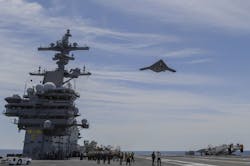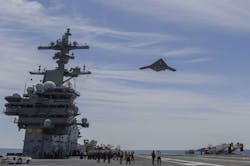Northrop Grumman X-47B UCAS running on Wind River VxWorks catapults from aircraft carrier
By Chip Downing, Senior Director of Aerospace & Defense, Wind River
ALAMEDA, Calif., 16 May 2013. The Northrop Grumman X-47B unmanned aircraft achieved a catapult launch from the deck of the USS George H.W. Bush carrier, the first of its kind in aviation history. This marks a very proud day for Wind River knowing that our VxWorks real-time operating system is a key technology for this aircraft, developed as part of the Navy’s Unmanned Combat Air System Carrier Demonstration (UCAS-D) program.
Northrop Grumman's X-47B is a tailless, strike fighter-sized unmanned aircraft currently under development for carrier operations. VxWorks serves as the foundation for the Common Core System, the backbone of UCAS-D computers, networks, and interfacing electronics on the X-47B. Built on VxWorks, Northrop Grumman engineers were able to rapidly create, deploy and maintain the safety-critical control system.
This is a significant achievement following a series of proof of concept demonstrations to assess the viability of an unmanned system's operation aboard a carrier. The video of the X-47B doing its first carrier launch can be seen here.
This started with the first flight in July 2012 at Pax River Naval Air Station, after several flights it then performed the first land based catapult launch in November 2012, and performed its first arrested landing in May this year. As well as flight testing, the X-47B performed sea trials and performed a series of tests, included taxiing the X-47B on the flight deck, maneuvering the aircraft up to the ship's catapults, taxiing the aircraft over the ship's arresting cables, conducting fuelling operations and mixing the X-47B with other manned naval operations. And now this historic catapult launch milestone can be added to the list.
Congratulations to the U.S. Navy and Northrop Grumman!
Wind River’s software has served as the foundation for countless autonomous systems around the globe, including the Mars Science Laboratory rover Curiosity, Centro Italiano di Ricerche Aerospaziali’s FTB-1 reusable unmanned spacecraft, and the nEUROn Unmanned Combat Air Vehicle demonstrator, among others.

